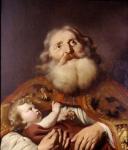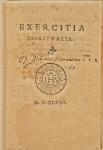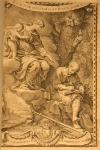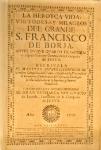A Portrait in Search of an Identity

A Jesuit Saint: San Francisco de Borja, 1726
We have never known the appearance of Christ’s disciples, the martyrs of the early Church or the medieval saints. They lived and died centuries before the emergence of portraiture in European art. Artists developed iconography (a combination of the Greek words: ikon meaning image and graphein, “to write”) so that each saint was readily identifiable by the faithful. Colors, symbols and objects became the saints’ identifiers rather than their features.
As portraiture developed, an artist might endow a saint with portrait-like features. Consider Simeon in Thomas de Keyser’s Simeon and the Christ Child. As individualistic as his features are, they are not the means by which we identify the old man who held Christ in the Temple.

Simeon and the Christ Child, 1639
Thomas de Keyser, a leading portraitist of his time, has captured the radiant joy of Simeon, whom the Holy Ghost told would not die until he had seen Christ. Simeon was present at the Temple when Mary performed her purification rituals. Portrayed as a priest in a cope, Simeon recites his canticle, Nunc Dimittis: “Lord, now lettest thou thy servant depart in peace, according to thy word.”
But what of the newer Counter-Reformation saints, who had lived in an age of portraiture and whose visage had been known to the faithful and had been recorded? Were portrait features incorporated into the traditional artistic lexicon of iconography?
That is the conundrum presented by this painting/portrait by the early 18th-century Spanish artist, Bernardo Lorente Germán. Dated along the table’s edge, 1726, it is his earliest known work. He was later to distinguish himself as a portraitist of the Spanish Court during its five-year residence in his native Seville.
Iconography informs us that this man is a Jesuit saint. He holds in his hand a monstrance that bears the Jesuit emblem, Christ’s monogram, IHS.

Exercitia Spiritualia by Ignatius of Loyola, 1548
Several of the books behind him are Jesuit texts. The Society of Jesus was founded in 1540. It grew rapidly into one of the strongest and wealthiest orders in the Church. In 1726, two new Jesuit saints, Aloysius Gonzaga and Stanislaus Kostka, were added to the tally of three: Ignatius of Loyola – the Society’s founder, Francis Xavier and Francisco de Borja.
Who then is this saint? The Contenders
Their number can be immediately reduced to just two, for the image of a middle-aged man in his study suits neither of the youthful saints canonized in 1726. A pendant (a mate in size and composition) to this painting, depicting St. Francis Xavier, survives in Seville.
The existence of a second version of this painting only confuses the matter. Until recently, LUMA’s painting was identified declaratively as St. Ignatius of Loyola, while the second version (in a private Madrid collection) is said to be of San Francisco de Borja. An examination of auction records indicates that both identifications are relatively new. LUMA’s painting was sold in 1954 with the title “A Saint in Black,” while the Madrid version was listed as recently as 1999 as simply “A Prelate.” Neither man was recognized as a Jesuit.
St. Ignatius of Loyola (1491-1556)

Exercitia Spiritualia by Ignatius of Loyola, 1644
The youthful Order revered its founder, whose Spiritual Exercises (depicted along the painting’s left-hand edge) proved a cornerstone of Jesuit spirituality. Ignatius himself devised the Order’s emblem (IHS) in a radiant aureole, but it is highly unusual that it should be displayed in a monstrance, a stemmed vessel traditionally used to display a relic or the Host. Compare it with the aureole in the School of Cuzco Madonna and Child with Four Jesuits also in this gallery. The skull and discipline (whip for self-flagellation) are unusual attributes for Ignatius of Loyola. Furthermore, this man simply does not look like him.
Nicolás de Bodadilla, one of his companions, painted Ignatius’ portrait and a face mask was cast upon his death. Superior General Claudio Acquaviva (1581-1615) promoted Ignatius’ historical likeness through engravings as part of his campaign for canonization. Ignatius had had a high forehead, bald crown and beard, features missing in this portrait.
San Francisco de Borja (1510-1572)

La Heroyca Vida, Virtudes, y Milagros del Grande S. Francisco de Borja by Alvaro Cienfuegos, 1717
The third Superior General of the Order (1565-1572), he was born into a Spanish noble house and succeeded to the dukedom of Gandia. He held high office at the court of the Holy Roman Emperor, Charles V. He renounced his position to enter the Jesuit Order as a simple priest in 1551.

Opera Omnia by Francisco de Borja, 1675
Although a death mask was cast of Borja, his appearance was not so well established and, by the early 17th century, had become confused with that of Ignatius. He could be depicted either with a beard or without; however, a skull was his characteristic attribute, a symbol of his repudiation of his noble rank. As suggested by the books on the bookshelves, he favored a life of intense spiritual devotion. Although Jesuits had not worn clerical garb in Ignatius’ day, Borja instituted it; both this figure and St. Francis Xavier were depicted so dressed.
The Curator’s Opinion
I recognize that my questioning of a painting formerly identified as St. Ignatius of Loyola is controversial. I myself would not have called into doubt the identification had not so many of Loyola University Chicago’s Jesuits done so. At this juncture, I cannot definitively settle the matter but believe that the preponderance of evidence suggests that this work is an image if not a portrait of San Francisco de Borja.
I propose that this painting, Bernardo Lorente Germán’s earliest dated work, was commissioned along with that of St. Francis Xavier to celebrate the 1726 canonizations of Aloysius Gonzaga and Stanislaus Kostka. The paintings’ relatively small size and simple study settings suggest that they were intended for use within a Jesuit house rather than a public space.
The image of St. Francis Xavier exhibits a curious combination of iconography and individualization, whether based upon factual knowledge or not. Forty-six at his death, the saint was traditionally depicted as youthful, with a full head of curly black hair and a bushy beard. His attributes include lilies for purity, a flaming heart for religious ardor, a crucifix and clerical dress. That he stands in a somber rather than exotic setting (he died on the Chinese island of Shangchuan) with a skull, writing implements, a book and whip says as much about the nature of the Jesuit Order in the early18th century as it does the historical saint.

The Death of St. Francis Xavier, 18th century
This fact may be the key to the identification of LUMA’s Jesuit saint. Clerical garb and a greater emphasis on an austere devotional spiritual life were the legacies of San Francisco de Borja’s generalship of the Order. His physical similarity to Ignatius may simply reflect confusion as to Borja’s own appearance, something that Jesuit historians have recognized, or may have been intentional, to underscore a spiritual lineage between the two Superiors General.

A Jesuit Saint: San Francisco de Borja, 1726
We have never known the appearance of Christ’s disciples, the martyrs of the early Church or the medieval saints. They lived and died centuries before the emergence of portraiture in European art. Artists developed iconography (a combination of the Greek words: ikon meaning image and graphein, “to write”) so that each saint was readily identifiable by the faithful. Colors, symbols and objects became the saints’ identifiers rather than their features.
As portraiture developed, an artist might endow a saint with portrait-like features. Consider Simeon in Thomas de Keyser’s Simeon and the Christ Child. As individualistic as his features are, they are not the means by which we identify the old man who held Christ in the Temple.

Simeon and the Christ Child, 1639
Thomas de Keyser, a leading portraitist of his time, has captured the radiant joy of Simeon, whom the Holy Ghost told would not die until he had seen Christ. Simeon was present at the Temple when Mary performed her purification rituals. Portrayed as a priest in a cope, Simeon recites his canticle, Nunc Dimittis: “Lord, now lettest thou thy servant depart in peace, according to thy word.”
But what of the newer Counter-Reformation saints, who had lived in an age of portraiture and whose visage had been known to the faithful and had been recorded? Were portrait features incorporated into the traditional artistic lexicon of iconography?
That is the conundrum presented by this painting/portrait by the early 18th-century Spanish artist, Bernardo Lorente Germán. Dated along the table’s edge, 1726, it is his earliest known work. He was later to distinguish himself as a portraitist of the Spanish Court during its five-year residence in his native Seville.
Iconography informs us that this man is a Jesuit saint. He holds in his hand a monstrance that bears the Jesuit emblem, Christ’s monogram, IHS.

Exercitia Spiritualia by Ignatius of Loyola, 1548
Several of the books behind him are Jesuit texts. The Society of Jesus was founded in 1540. It grew rapidly into one of the strongest and wealthiest orders in the Church. In 1726, two new Jesuit saints, Aloysius Gonzaga and Stanislaus Kostka, were added to the tally of three: Ignatius of Loyola – the Society’s founder, Francis Xavier and Francisco de Borja.
Who then is this saint? The Contenders
Their number can be immediately reduced to just two, for the image of a middle-aged man in his study suits neither of the youthful saints canonized in 1726. A pendant (a mate in size and composition) to this painting, depicting St. Francis Xavier, survives in Seville.
The existence of a second version of this painting only confuses the matter. Until recently, LUMA’s painting was identified declaratively as St. Ignatius of Loyola, while the second version (in a private Madrid collection) is said to be of San Francisco de Borja. An examination of auction records indicates that both identifications are relatively new. LUMA’s painting was sold in 1954 with the title “A Saint in Black,” while the Madrid version was listed as recently as 1999 as simply “A Prelate.” Neither man was recognized as a Jesuit.
St. Ignatius of Loyola (1491-1556)

Exercitia Spiritualia by Ignatius of Loyola, 1644
The youthful Order revered its founder, whose Spiritual Exercises (depicted along the painting’s left-hand edge) proved a cornerstone of Jesuit spirituality. Ignatius himself devised the Order’s emblem (IHS) in a radiant aureole, but it is highly unusual that it should be displayed in a monstrance, a stemmed vessel traditionally used to display a relic or the Host. Compare it with the aureole in the School of Cuzco Madonna and Child with Four Jesuits also in this gallery. The skull and discipline (whip for self-flagellation) are unusual attributes for Ignatius of Loyola. Furthermore, this man simply does not look like him.
Nicolás de Bodadilla, one of his companions, painted Ignatius’ portrait and a face mask was cast upon his death. Superior General Claudio Acquaviva (1581-1615) promoted Ignatius’ historical likeness through engravings as part of his campaign for canonization. Ignatius had had a high forehead, bald crown and beard, features missing in this portrait.
San Francisco de Borja (1510-1572)

La Heroyca Vida, Virtudes, y Milagros del Grande S. Francisco de Borja by Alvaro Cienfuegos, 1717
The third Superior General of the Order (1565-1572), he was born into a Spanish noble house and succeeded to the dukedom of Gandia. He held high office at the court of the Holy Roman Emperor, Charles V. He renounced his position to enter the Jesuit Order as a simple priest in 1551.

Opera Omnia by Francisco de Borja, 1675
Although a death mask was cast of Borja, his appearance was not so well established and, by the early 17th century, had become confused with that of Ignatius. He could be depicted either with a beard or without; however, a skull was his characteristic attribute, a symbol of his repudiation of his noble rank. As suggested by the books on the bookshelves, he favored a life of intense spiritual devotion. Although Jesuits had not worn clerical garb in Ignatius’ day, Borja instituted it; both this figure and St. Francis Xavier were depicted so dressed.
The Curator’s Opinion
I recognize that my questioning of a painting formerly identified as St. Ignatius of Loyola is controversial. I myself would not have called into doubt the identification had not so many of Loyola University Chicago’s Jesuits done so. At this juncture, I cannot definitively settle the matter but believe that the preponderance of evidence suggests that this work is an image if not a portrait of San Francisco de Borja.
I propose that this painting, Bernardo Lorente Germán’s earliest dated work, was commissioned along with that of St. Francis Xavier to celebrate the 1726 canonizations of Aloysius Gonzaga and Stanislaus Kostka. The paintings’ relatively small size and simple study settings suggest that they were intended for use within a Jesuit house rather than a public space.
The image of St. Francis Xavier exhibits a curious combination of iconography and individualization, whether based upon factual knowledge or not. Forty-six at his death, the saint was traditionally depicted as youthful, with a full head of curly black hair and a bushy beard. His attributes include lilies for purity, a flaming heart for religious ardor, a crucifix and clerical dress. That he stands in a somber rather than exotic setting (he died on the Chinese island of Shangchuan) with a skull, writing implements, a book and whip says as much about the nature of the Jesuit Order in the early18th century as it does the historical saint.

The Death of St. Francis Xavier, 18th century
This fact may be the key to the identification of LUMA’s Jesuit saint. Clerical garb and a greater emphasis on an austere devotional spiritual life were the legacies of San Francisco de Borja’s generalship of the Order. His physical similarity to Ignatius may simply reflect confusion as to Borja’s own appearance, something that Jesuit historians have recognized, or may have been intentional, to underscore a spiritual lineage between the two Superiors General.
